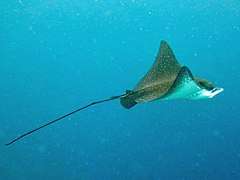Aetobatus ocellatus
The ocellated eagle ray (Aetobatus ocellatus) is a species of cartilaginous fish in the eagle ray family Myliobatidae. It is found in the tropical Indo-West Pacific region.[2][3] In the past it was included in the spotted eagle ray (A. narinari), a species restricted to the Atlantic after the split.[4][5][6]
| Aetobatus ocellatus | |
|---|---|
 | |
| Aetobatus ocellatus in the Maldives | |
| Scientific classification | |
| Kingdom: | |
| Phylum: | |
| Class: | |
| Order: | |
| Family: | |
| Genus: | |
| Species: | A. ocellatus |
| Binomial name | |
| Aetobatus ocellatus (Kuhl, 1823) | |
Description and behavior
Compared to the Spotted eagle ray, A. ocellatus has a longer tail (mean total length 281 vs. 263% DW) and a longer stinging spine (mean length 9.7 vs. 8.9% DW). The background coloration of the dorsal surface in A. ocellatus is dark greenish/greying to almost blackish whereas A. narinari is much paler, medium yellowish to brownish.[4] Their foraging range is based on anthropogenic noises with populations structured according to ontogenetic stage.[7]
Reproduction
The ocellated eagle ray exhibits Ovoviviparity with embryos feeding on yolk initially, then receiving additional nutrients from the mother through indirect absorption of enriched uterine fluid.[8] The gestation period lasts over 12 months and only produces a few pups.[9]
Diet
The ocellated eagle ray feeds primarily on gastropod, bivalve molluscs, crustaceans, worms, octopuses and fishes.[10]
References
| Wikimedia Commons has media related to Aetobatus ocellatus. |
- Kyne, P.M., Dudgeon, C.L., Ishihara, H., Dudley, S.F.J. & White, W.T. (2016). Aetobatus ocellatus. The IUCN Red List of Threatened Species doi:10.2305/IUCN.UK.2016-1.RLTS.T42566169A42566212.en
- "Aetobatus ocellatus (Kuhl, 1823)". FishBase. Retrieved 2015-05-17.
- Kuhl, H. in van Hasselt, J.C. (1823) Uittreksel uit een’ brief van Dr. J. C. van Hasselt, aan den Heer C. J. Temminck. Algemein Konst- en Letter-bode I Deel (no. 20): 315–317.
- White, W.T., P.R. Last, G.J.P. Naylor, K. Jensen & J.N. Caira (2010). Clarification of Aetobatus ocellatus (Kuhl, 1823) as a valid species, and a comparison with Aetobatus narinari (Euphrasen, 1790) (Rajiformes: Myliobatidae). Pp. 141-164 in: Last, P.R., White, W.T. & Pogonoski, J.J., eds. (2010). Descriptions of new sharks and rays from Borneo. CSIRO Marine and Atmospheric Research Paper no. 32.
- Richards, V.P., M. Henning, W. Witzell & M.S. Shivji (2009). Species delineation and evolutionary history of the globally distributed spotted eagle ray (Aetobatus narinari). J Hered. 100(3): 273-83. doi: 10.1093/jhered/esp005
- White, W.T. (2014): A revised generic arrangement for the eagle ray family Myliobatidae, with definitions for the valid genera. Zootaxa, 3860 (2): 149–166.
- Lecchini, David (2018). "Distribution patterns of ocellated eagle rays, Aetobatus ocellatus, along two sites in Moorea Island, French Polynesia". CYBIUM. 42 (4): 313–320.
- Dulvy, N.K. and J.D. Reynolds, 1997. Evolutionary transitions among egg-laying, live-bearing and maternal inputs in sharks and rays. Proc. R. Soc. Lond., Ser. B: Biol. Sci. 264:1309-1315.
- Schluessel, V (2010). "Diet and reproduction in the white-spotted eagle ray Aetobatus nari- nari from Queensland, australia and the Penghu islands, Taiwan". Mar. Freshw. Res. 61:1278-1289.
- Randall, J.E. and Cea, A. (2011). Shore fishes of Easter Island. University of Hawai'i Press, 164 p.
